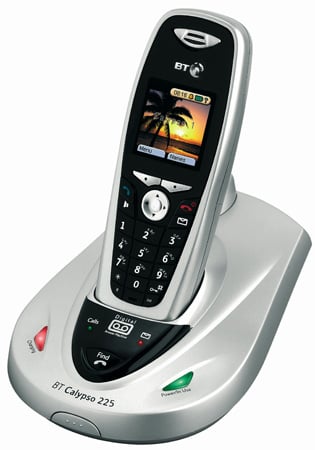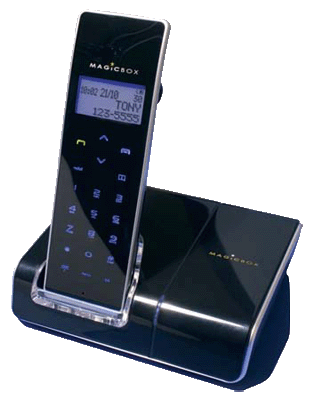This article is more than 1 year old
Hit the DECT: cordless phones on test
Ten cordless phones for your consideration
Bang & Olufsen BeoCom 2

Once you’ve recovered your senses from the fact that you’ve just shelled out half a grand for a DECT phone, you’ll begin to appreciate the finer points of high-end manufacturer Bang & Olufsen’s BeoCom 2.
Crafted from a single slither of brushed aluminium and offered in a range of six colour schemes, the unique and accentuated curve design stands it alone in the DECT phone world as a style statement and piece of modern art first and a communications device second. Because, considering the cost, it isn’t exactly packed with bells and whistles.
But what it does it does well. Call quality is stunning – completely crystal clear – and thanks to that ergonomic head-shaped design, you’ll find yourself ramping up the phone bill fast because this handset's such a pleasure to use. The more you use it the more likely your chums are to see it, which is clearly the main reason for owning such a gadget.
It comes with a 200-entry phonebook that is created as you make and receive calls, and a 24-strong received and made call log, alongside caller ID and other basic functions. You can also operate six BeoComs from one unit if you so desire - though you may have to remortgage for the privilege at a cost of £3,000! - and then use them as an intercom system around the home. The feature Bang & Olufsen seem most excited about though is the BeoCom’s unique ringtone, a ‘natural and tranquil’ sound designed to remove the urgency to answer any time soon. A nice feature – unless you’re the one calling. And waiting. And waiting. And waiting.
Bang & Olufsen BeoCom 2
| Best for indulgence
Is it a banana? Is it a phone? Is it way too expensive? Two out of three's not bad... |
| Price | From £500 inc VAT |
|---|---|
| More info | B&O's website |
BT Calypso 225

The domination of the mobile phone has taken its toll on DECT’s popularity, but companies like BT are responding by transforming the cordless into something not so far removed from its more versatile cousin. The Calypso 225 is the next step in this evolution, featuring the likes of a colour screen, SMS capability and a built-in SIM card reader.
The sunny sounding Calypso is a curious-looking beast that’s left the fashion gurus here at Register Hardware in a state of mild confusion, because we just can’t decide whether it’s a bold style statement in the vein of a 1980s Casio calculator, or a hideous melding of tacky black and silver to be hidden in the under-stairs cupboard.
In use the 225 is adequate if not spectacular thanks to a low hum invading some conversations and a not-quite-crystal call quality. One thing we are in no doubt about, however, is its functionality. Available with up to three extra handsets - marketed as the Quad - it features a plethora of useful add-ons alongside basic functionality like 20 dialled and 50 call log capacity, massive 200-contact memory, eight ringtones and the ubiquitous polyphonic ringer. BT has usefully also thrown conference call facility and answering phone into the mix, which is discreet enough to have little impact on the size and style of the base-station and offers an adequate 20-minute digital recording capacity.
Functionality has also been derived from the mobile world, with the Calypso’s distinctly Nokia-esque menu system a cinch to navigate and familiarise yourself with. Just plug it in, slip you mobile’s SIM in the dock and you’ll be up and running in no time with a full contact list, the ability to send and receive texts, full colour screen with caller ID, wallpapers, clock, alarm and everything else you’d expect from a mobile, sorry DECT phone.
BT Calypso 225
| Best for mobile-phone lovers
Don’t get your hopes up, it’s not a revival of the fizzy drinks firm but BT’s mobile-style home phone |
| Price | From £70 inc VAT |
|---|---|
| More info | The BT consumer website |

The MagicBox Touch is one of a new wave of DECT phones looking to set itself apart from the pack by offering up a unique design feature. As you can likely guess from the name, this phone features an entirely touch-sensitive fascia in place of the traditional - and, it has to be said, entirely functional - keypad.
MagicBox’s biggest success with the Touch is its styling – it’s a beautiful bit of kit that’s following the en vogue trend of piano-black finish and smooth, curved corners with a nice metallic detail. When inactive, the Touch’s keypad is completely invisible, rendering it monolith-esque in looks with nothing but the diminutive two-tone screen and MagicBox logos visible on both the phone and its dock. Though there is an unnervingly bright blue standby light, which may be a little annoying on, say, your bedside table.
Receive a call though, and it’s all change as the whole things lights up in a ridiculously pleasing icy blue glow revealing a standard number layout, navigational directions and that slightly underwhelming display. Features include a 60-contact phonebook, 20-number call log, ten polyphonic ringtones and caller ID. There’s also intercom and speakerphone functionality.
In use the MagicBox is great to look at and call quality is perfectly decent if a little muffled in comparison to some of the phones on test. But the real issue unfortunately came with the touchscreen. Like most mobiles before it that have opted this route from a purely aesthetic point of view, the simple truth is that a touchscreen is rubbish in comparison to the trad keypad. We found ourselves accidentally cutting people off, upping the speaker volume or pressing random keys with our (admittedly large) ears during calls, or else struggled to hit the right keys in order when dialling numbers, which made using the MagicBox more of a chore than a pleasure.
MagicBox Touch 100
Best for novelty
MagicBox gets touchy with its latest DECT phone

Price
From £80 inc VAT
More info
MagBox's website
| Best for novelty
MagicBox gets touchy with its latest DECT phone |
| Price | From £80 inc VAT |
|---|---|
| More info | MagBox's website |
